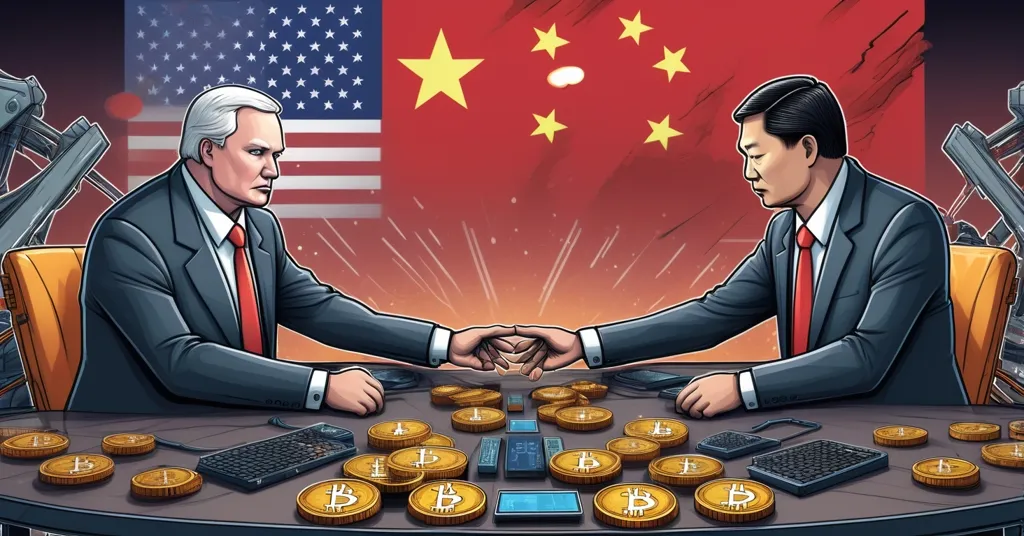U.S.-China Trade Talks Threaten Bitcoin Mining with Supply Chain Chaos

U.S.-China Trade Talks in Malaysia: A Looming Threat to Bitcoin Mining and Blockchain Innovation
Senior U.S. and Chinese officials met in Kuala Lumpur, Malaysia, on Saturday to grapple with escalating trade disputes that could spark a full-blown tariff war, with ripple effects threatening global markets and the crypto industry. As Presidents Trump and Xi Jinping gear up for a pivotal summit in South Korea, the stakes couldn’t be higher—especially for Bitcoin miners and blockchain enthusiasts facing potential supply chain chaos.
- Critical Meeting: U.S. and Chinese officials convened in Kuala Lumpur to de-escalate trade tensions before a Trump-Xi summit.
- Major Risks: Tariffs, rare earth export controls, and tech restrictions could disrupt Bitcoin mining hardware supply chains.
- Broader Impact: Outcomes may shape the future of decentralized technology amid geopolitical chaos.
Setting the Stage: Trade Tensions Boil Over in Kuala Lumpur
The backdrop for this urgent dialogue was the Merdeka 118 tower in Kuala Lumpur, the world’s second-tallest building, where U.S. Treasury Secretary Scott Bessent and Trade Representative Jamieson Greer faced off with China’s Vice Premier He Lifeng and trade negotiator Li Chenggang. The timing is critical—President Donald Trump has threatened to impose 100% tariffs on Chinese goods starting November 1, a direct retaliation to China’s October 10 announcement of restrictions on rare earth magnets and minerals. These materials, vital for everything from smartphones to defense systems, are also the unsung heroes of Bitcoin mining hardware, powering the specialized components that keep the network humming.
For those new to the space, Bitcoin mining relies on Application-Specific Integrated Circuits (ASICs)—custom-built hardware designed solely to solve the complex math problems that secure the blockchain and earn miners BTC rewards. But here’s the kicker: many of these rigs depend on rare earths like neodymium and dysprosium, used in magnets for cooling systems. China controls roughly 80% of global rare earth production, and their latest export curbs have U.S. officials calling it a “global supply chain power grab.”
Global supply chain power grab.
That phrase from Bessent and Greer isn’t just rhetoric—it’s a warning shot. If Beijing tightens the screws further, ASIC manufacturers could face shortages, jacking up costs for miners already battling high energy bills and network difficulty (a measure of how hard it is to mine a block, which adjusts based on the total computing power on the network). For small-scale miners, a potential 20-30% price spike in hardware could be a death knell. Even large operations might struggle to scale, risking a drop in Bitcoin’s hash rate—the total computational power securing the network.
A Fragile Truce on the Brink of Collapse
To understand how we got here, let’s rewind. Back in May, a 90-day pause on trade hostilities was brokered in Geneva, slashing U.S. tariffs on Chinese goods to about 55% and Chinese tariffs to 30%. Extensions followed in London and Stockholm, but this shaky truce expires on November 10. Tensions flared anew in late September when the U.S. Commerce Department expanded its export blacklist—a policy blocking American tech and goods from reaching thousands of Chinese companies. China hit back with rare earth controls, and just last Friday, Washington launched a probe into whether Beijing violated the 2020 “Phase One” trade deal, a landmark agreement that briefly halted the trade war during Trump’s first term.
These aren’t just numbers and policies; they’re punches in a high-stakes brawl. Since 2018, the U.S. has slapped over $550 billion in tariffs on Chinese goods, with retaliatory measures from China gutting bilateral trade volume at peak conflict. Beyond tariffs, the Kuala Lumpur talks tackled potential relief measures, easing U.S. tech export bans, and resuming American soybean exports to China. Taiwan also loomed large, though Trump confirmed he has no plans to visit the self-ruled island. While these issues might seem distant from crypto, they’re not—every tariff or restriction reshapes the global economic chessboard where blockchain tech is a growing player.
Why Bitcoin Miners and Blockchain Devs Should Be on Edge
For the crypto crowd, this geopolitical mess isn’t just background noise—it’s a direct threat to your rig setup or your next big decentralized project. Rare earth export controls could throttle the supply of Bitcoin mining hardware, pushing costs through the roof. Think of these minerals as the oil in your car engine; without them, the whole machine grinds to a halt. If China plays hardball, miners might face delays or outright shortages, hitting profitability harder than a bear market dump.
But it’s not just Bitcoin. Ethereum miners—even post-merge with its shift to Proof-of-Stake—still rely on GPUs for other chains or pre-merge setups, and those cards need rare earth components too. Broader blockchain projects, like decentralized storage solutions (think Filecoin or Arweave), depend on hardware for nodes and servers. Then there’s the altcoin ecosystem—layer-2 scaling solutions and DeFi platforms often require cutting-edge tech that could get snagged in export bans. If U.S.-China tech restrictions escalate, cross-border collaboration on decentralized tech could stall, slowing innovation at a time when we need it most.
Let’s not sugarcoat it: decentralization on-chain doesn’t mean squat if your off-chain supply lines are choked. Sure, Bitcoin was built to sidestep centralized financial systems, laughing in the face of borders and bureaucrats. But when Beijing says “nope” to shipping your miner parts, all the hodling in the world won’t save you. This is the ugly reality we can’t ignore—crypto’s physical infrastructure is still tethered to the same broken global trade system we’re trying to escape.
Playing Devil’s Advocate: Could Chaos Breed Progress?
Before we spiral into doom, let’s flip the script. Trade wars suck, no doubt, but they might light a fire under the crypto community’s ass. Bitcoin has weathered storms before—remember China’s 2021 mining ban? Hash rate tanked, then rebounded as miners pivoted to places like Texas and Kazakhstan. Some operations might now source hardware from alternative markets or recycle components, dodging rare earth dependency. Hell, this mess could even spark innovation in open-source, decentralized manufacturing for mining gear—think 3D-printed ASIC designs or community-built rigs. If anything, these tensions align with effective accelerationism (e/acc), the idea that chaos turbocharges tech progress. Disruption might just be the push we need to build a truly resilient blockchain ecosystem.
On the flip side, economic instability could drive more folks to Bitcoin as a hedge against inflation and fiat devaluation. When tariffs and trade spats tank traditional markets, decentralized alternatives start looking mighty fine. But let’s not get carried away—supply chain pain doesn’t equal instant BTC moons. And don’t fall for the Twitter clowns shilling $1M price predictions off the back of trade war fears; that’s just noise, not signal. Real adoption comes from understanding the grind, not chasing hype.
Malaysia’s Role and the Southeast Asian Crypto Connection
Malaysia hosting these talks isn’t random. Kuala Lumpur serves as neutral ground, a nod to Southeast Asia’s rising clout in global trade diplomacy, as seen in recent efforts to defuse U.S.-China trade tensions. This region matters to crypto too—Singapore is a blockchain adoption powerhouse, and countries like Thailand and Vietnam are seeing DeFi and NFT projects flourish. As U.S.-China tensions spill over, neutral players like Malaysia could shape trade policies that either help or hinder crypto growth. Imagine if Southeast Asia brokered deals that prioritized tech access for blockchain hubs; it’d be a game-changer. For now, though, Kuala Lumpur is just the stage for a drama that’s far from over.
Eyes on South Korea: The Trump-Xi Showdown
The Kuala Lumpur meeting is merely the opener. Next Thursday, Trump and Xi Jinping are set for a face-to-face at an economic summit in South Korea. If they strike a deal, we might see temporary tariff relief, eased tech restrictions, or renewed agricultural trade—small wins that could stabilize markets and indirectly ease pressure on crypto supply chains. If they flop, brace for economic fallout that’ll hit harder than a leveraged wipeout. For Bitcoin and blockchain, the stakes are personal. Every tariff hike or export ban reshapes the landscape we operate in, testing the resilience of a financial revolution built on defying the status quo.
Key Takeaways and Questions for Crypto Enthusiasts
- What’s fueling the current U.S.-China trade tensions?
The fire comes from Trump’s threat of 100% tariffs on Chinese goods starting November 1, China’s rare earth export controls since October 10, and U.S. export bans on thousands of Chinese firms, alongside disputes over the 2020 “Phase One” trade deal. - How could the Trump-Xi summit in South Korea affect crypto markets?
A successful outcome might ease tariffs and tech restrictions, stabilizing supply chains for Bitcoin mining hardware; a failure could escalate tensions, driving up costs and disrupting blockchain tech development. - Why do rare earth minerals matter to Bitcoin miners?
These minerals, like neodymium, are crucial for ASIC hardware components; China’s export curbs could cause shortages, spike prices by 20-30%, and hit smaller miners hardest. - Are altcoins and other blockchain projects at risk too?
Absolutely—Ethereum mining rigs, decentralized storage nodes, and DeFi infrastructure all rely on hardware tied to rare earths and global tech trade, facing delays or cost hikes if tensions worsen. - Could trade wars actually boost crypto adoption?
Possibly, as economic chaos might push people toward Bitcoin as a safe haven, though supply chain disruptions could offset short-term gains with hardware scarcity. - How can Bitcoin miners prepare for potential supply chain disruptions?
Diversify hardware sources, explore recycled components, or invest in energy-efficient setups to weather shortages—adaptability is key, just like after China’s 2021 mining crackdown. - Is there a silver lining for decentralized tech in this mess?
Yes, trade disruptions could force innovation—think open-source mining gear or decentralized manufacturing—aligning with the ethos of building resilient, unstoppable systems.
Stepping back, the Kuala Lumpur talks and looming South Korea summit are more than geopolitical theater—they’re a stress test for Bitcoin and the broader blockchain space. We’re fighting for a financial future free from centralized control, yet we’re still chained to physical supply lines that can snap under trade war pressure. The path forward demands grit: diversifying our hardware dependencies, accelerating innovation, and staying skeptical of hype while pushing for real adoption. As the U.S. and China duke it out, one truth stands firm—crypto’s greatest strength is its ability to adapt, even when the world’s biggest players try to stack the deck against us. Let’s keep building, no matter the odds.



